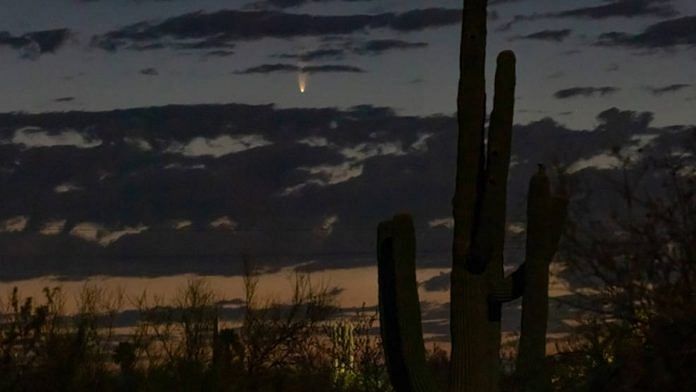Bengaluru: The comet NEOWISE will be making its closest approach to Earth Thursday, passing by at a distance of 103 million kilometres. NEOWISE is fading away slowly as it moves farther from the Sun, dimming in visibility.
The comet will be visible after sunset around the world in the north west direction. In India, it will be visible until around 9:30pm. Before 12 July, the comet was visible in the early hours of the morning.
Officially named C/2020 F3, comet NEOWISE was first detected approaching the Sun in March this year by the Wide-field Infrared Survey Explorer (WISE) space telescope’s Near-Earth Objects (NEO) mission. It made its closest approach to the sun on 3 July 2020.
While it continues to be visible to the naked eye in most parts of the world, some places with low visibility might require a basic pair of binoculars to see the comet.
Also read: Catch a comet sighting in India as NEOWISE remains visible through July into August
How to see it
In the northern hemisphere, including India, the comet is visible with the naked eye in the night sky after sunset. It is visible just south of the Big Dipper constellation, also known as Saptarishi in India.
The constellation is also called Ursa Major and is commonly thought to look like a frying pan or a plough. NEOWISE is about 23 degrees southeast of the two stars that make up the bottom of Big Dipper’s bowl shape.
Comet Neowise and the Big Dipper over the next few days pic.twitter.com/EADUd9iR2N
— Con Stoitsis (@vivstoitsis) July 20, 2020
While the comet itself can be seen with the eye, binoculars would make its tails more prominent, along with a likely green or blue tinge. Skygazing apps like Sky Guide can also track and point to the comet.
In India, the comet sets at 9:30pm. In northern latitudes, it’s visible for longer into the night. While the darker sky would make it easier to spot, the crescent moon’s brightness may make it difficult to find the comet. However, the moon sets at around 8.30pm, giving a one-hour window for a clearer view.
It is currently climbing at the horizon, visible higher and higher in the sky each day as it dims.
Also read: Solar Orbiter captures closest photos of Sun ever taken, scientists discover ‘camp fires’
About comet NEOWISE
NEOWISE is named after the WISE telescope that detected it, which images the sky in the infrared wavelength, scanning for near-earth objects (NEO). It orbits the Earth once every 95 minutes.
The comet is currently flying at 13,942 kilometres per hour.
Its appearance has given researchers access to unprecedented data as such bright comets are not too common each year.
It has two tails, one made of dust and gas, and one made of ionised gas. Two cometary tails are typically present in other comets as well, but researchers think NEOWISE also has a tail made of sodium.
Because cometary tails are created by the solar wind and radiation from the sun, they always flare out in the direction opposite to the Sun, irrespective of the direction of the comet’s orbit. As the comet moves away from the sun, cometary tails lead the nucleus, like they do for NEOWISE today.
The comet will dim as it moves farther from the Sun due to lack of both light and heat, which cause gases to escape, making the comet visible.
NEOWISE will not be visible from Earth again for another 6,800 years as it completes its orbit around the sun.
Also read: UAE sends Hope to Mars in the Arab world’s first mission to the Red Planet







I am aslo trying from several days.But it not seen.This media’s are bullshit…
lucky u r …. i m trying from last 5 days but cant see bcz of weather and cloud….grt capture
Has anyone seen the neowise 2020 comet in India. I have been trying to see it for several days but could not. All the information given in this article is so theoretical and often faulty. It is mentioned that the moon sets at 8:30 pm. Which is not right. Rest of the article is just cut and paste and shows your journalism in poor light.
Somnath Mukherjee
Today we saw it after sunset. It was visible from my hometown Margherita , Tinsukia. It was so beautiful.